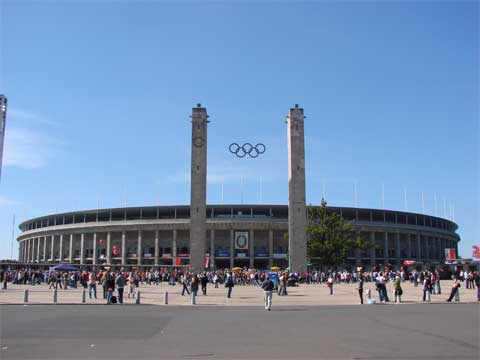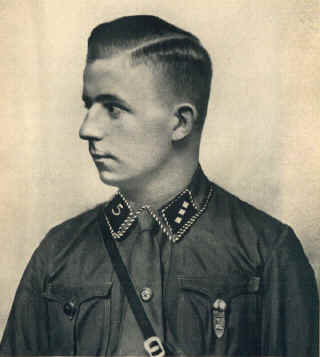Historical Knowledge Of The Third Reich

This will establish the depth of your knowledge regarding a variety of trivia of the Third Reich and WW2.
- 1.
Who was this person, convicted at Nuremberg?
- A.
Carl von Clausewitz
- B.
Eric Stroheim
- C.
Wilhelm Keitel
- D.
Julius Streicher
Correct Answer
D. Julius StreicherExplanation
Julius Streicher - Publisher of Der StürmerRate this question:
-
- 2.
The Butcher of Lyon was -
- A.
Klaus Barbie
- B.
Jerôme Daladaire
- C.
Ernst Jung
- D.
Rudolf Hess
Correct Answer
A. Klaus BarbieExplanation
Klaus Barbie is the correct answer because he was known as "The Butcher of Lyon." He was a Nazi war criminal who was responsible for numerous atrocities during World War II, particularly in Lyon, France. Barbie was the head of the Gestapo in Lyon and was involved in the arrest, torture, and deportation of thousands of people, including resistance fighters and Jewish individuals. His nickname, "The Butcher of Lyon," reflects the brutal and ruthless nature of his actions during the war.Rate this question:
-
- 3.
What was the inspirational quote above the entrance of the concentration camp Buchenwald?
- A.
Jedem das Seine
- B.
Arbeit macht Frei
- C.
Juden Heraus
- D.
Eure Ehre heißt Treue
Correct Answer
A. Jedem das SeineExplanation
The correct answer is "Jedem das Seine." This phrase translates to "To each his own" or "Everyone gets what they deserve." This quote was displayed above the entrance of the Buchenwald concentration camp during World War II. It was a cynical and cruel statement, reflecting the dehumanizing and discriminatory ideology of the Nazi regime, which believed in the unequal worth of individuals based on their race, religion, or political beliefs. The quote serves as a chilling reminder of the atrocities committed during the Holocaust and the need to remember and learn from history.Rate this question:
-
- 4.
Who is this actor who did an excellent portrayal of Hitler?
- A.
Christopher Waltz
- B.
Bruno Ganz
- C.
Horst Wessel
- D.
Johan Raabe
Correct Answer
B. Bruno GanzExplanation
Bruno Ganz is the correct answer because he is known for his exceptional portrayal of Adolf Hitler in the film "Downfall" (2004). Ganz's performance received critical acclaim for its accuracy and intensity, capturing the complexities of Hitler's character. His portrayal humanizes Hitler while also conveying the dictator's madness and charisma. Ganz's performance in "Downfall" is widely regarded as one of the most memorable portrayals of Hitler in cinema, showcasing his talent and skill as an actor.Rate this question:
-
- 5.
What was Hitlers eye colour?
- A.
Brown
- B.
Blue
- C.
Grey
- D.
Green
Correct Answer
B. BlueExplanation
Hitler's eye color was blue. This is a known fact based on various historical records, photographs, and eyewitness accounts. Blue eyes were a distinctive feature of Hitler's appearance, often described as intense and piercing.Rate this question:
-
- 6.
Who was this man with Danish origins who had a significant part in the rebuilding of Weimar Germany?
- A.
Holger Strøm
- B.
Peter Falke
- C.
Børge Bendtsen
- D.
Hjalmar Schacht
Correct Answer
D. Hjalmar SchachtExplanation
Hjalmar Schacht was a man with Danish origins who played a significant role in the rebuilding of Weimar Germany. He was an influential economist and banker who served as the President of the Reichsbank and Minister of Economics during the Weimar Republic. Schacht implemented various economic policies and reforms to stabilize the German economy after the devastation of World War I and the Treaty of Versailles. He also played a key role in the establishment of the Rentenmark, a new currency that helped stabilize inflation and restore confidence in the German economy. Schacht's efforts were crucial in the economic recovery of Weimar Germany.Rate this question:
-
- 7.
Who was this high ranking Nazi? He was unlawfully tried.
- A.
Arno Hintjens
- B.
Adolf Eichmann
- C.
Rudolf Hess
- D.
Herman von Papen
Correct Answer
B. Adolf EichmannExplanation
Adolf Eichmann was a high-ranking Nazi who was unlawfully tried. Eichmann was one of the key architects of the Holocaust and was responsible for organizing the deportation of millions of Jews to extermination camps. After World War II, he went into hiding but was eventually captured by Israeli agents in Argentina in 1960. He was then brought to Israel, where he stood trial for war crimes, crimes against humanity, and genocide. The trial was highly publicized and brought attention to the atrocities committed during the Holocaust. Eichmann was found guilty and executed in 1962.Rate this question:
-
- 8.
What was the name of this personal secretary?
- A.
Alfred Rosenberg
- B.
Alfred Jodel
- C.
Fritz Sauckel
- D.
Martin Bormann
Correct Answer
D. Martin BormannExplanation
Martin Bormann was the personal secretary of Adolf Hitler during World War II. He was known for his strong influence over Hitler and played a significant role in the Nazi regime. Bormann was responsible for managing Hitler's schedule, handling correspondence, and controlling access to the leader. He was considered one of the most powerful men in Nazi Germany and was involved in decision-making processes. Bormann's position as Hitler's personal secretary allowed him to exert considerable power and influence within the Nazi Party.Rate this question:
-
- 9.
Who designed this beautiful classicist stadium, still in use today?
- A.
Arno Breker
- B.
Arthur Krebs
- C.
Albert Speer
- D.
Anders Kløbbich
Correct Answer
C. Albert SpeerExplanation
Albert Speer is the correct answer because he was a German architect and a prominent member of the Nazi Party. He is known for his close association with Adolf Hitler and his role in designing many monumental buildings and structures during the Nazi regime. Speer's architectural style was heavily influenced by classicism, and he designed several stadiums, including the Olympic Stadium in Berlin, which is still in use today.Rate this question:
-
- 10.
Who was this party ideologue?
- A.
Alfred Rosenberg
- B.
Ejnar Roskild
- C.
Franz von Papen
- D.
Horst Pappenheimer
Correct Answer
A. Alfred RosenbergExplanation
Alfred Rosenberg was a party ideologue. He was a prominent figure in the Nazi Party and played a significant role in shaping Nazi ideology. He was one of the key architects of the anti-Semitic policies and was responsible for promoting the idea of Aryan supremacy. Additionally, Rosenberg was the editor of the Nazi newspaper, the Völkischer Beobachter, and held various high-ranking positions within the Nazi regime. His ideas and writings had a profound influence on the Nazi Party's ideology and policies during Hitler's rule.Rate this question:
-
- 11.
Who was this important diplomat?
- A.
Ernst Kaltenbrunner
- B.
Konstantin von Neurath
- C.
Erich Raeder
- D.
Joachim von Ribbentrop
Correct Answer
D. Joachim von RibbentropExplanation
Joachim von Ribbentrop was an important diplomat who served as the Minister of Foreign Affairs for Nazi Germany from 1938 to 1945. He played a key role in Hitler's aggressive foreign policies, including the signing of the Molotov-Ribbentrop Pact with the Soviet Union. Ribbentrop was known for his close relationship with Hitler and his active involvement in the planning and execution of Germany's military campaigns. After World War II, Ribbentrop was convicted of war crimes and crimes against humanity and was executed in 1946.Rate this question:
-
- 12.
Who was this important military and government leader?
- A.
Carl von Clausewitz
- B.
Joseph Goebbels
- C.
Adolf Eichmann
- D.
Karl Dönitz
Correct Answer
D. Karl DönitzExplanation
Karl Dönitz was an important military and government leader. He served as the Commander-in-Chief of the German Navy during World War II and later became the President of Germany for a short period after Hitler's death. Dönitz played a significant role in the planning and execution of naval operations during the war and was known for his expertise in submarine warfare. He was also responsible for the surrender of Germany to the Allies in 1945.Rate this question:
-
- 13.
Who was this homosexual leader?
- A.
Ernst Röhm
- B.
Udo Falke
- C.
Manni Petersheim
- D.
Horst-Günther Schrott
Correct Answer
A. Ernst RöhmExplanation
Ernst Röhm was a prominent figure in the early Nazi Party and a close associate of Adolf Hitler. He played a significant role in the organization and development of the paramilitary organization known as the Sturmabteilung (SA). Röhm's homosexuality was known to Hitler, but he was initially tolerated due to his loyalty and contributions to the party. However, as Hitler solidified his power, he saw Röhm and the SA as a potential threat and had Röhm and other SA leaders executed during the Night of the Long Knives in 1934.Rate this question:
-
- 14.
This man wrote a famous Nazi-song:
- A.
Deutschlandlied
- B.
Westerwald
- C.
Die Lore
- D.
Die Fahne hoch
Correct Answer
D. Die Fahne hochExplanation
Die Fahne hoch, also known as Horst-Wessel-Lied, was a famous Nazi song during the Third Reich in Germany. It was the anthem of the Nazi Party and played a significant role in promoting their ideology and rallying their supporters. The song was named after Horst Wessel, a prominent Nazi SA member who was glorified by the party after his death. The lyrics of Die Fahne hoch praised the Nazi movement, its leaders, and their vision for Germany. Due to its association with the Nazis, the song is now banned in Germany and considered a symbol of hate and extremism.Rate this question:
-
Quiz Review Timeline +
Our quizzes are rigorously reviewed, monitored and continuously updated by our expert board to maintain accuracy, relevance, and timeliness.
-
Current Version
-
Mar 21, 2023Quiz Edited by
ProProfs Editorial Team -
Jun 05, 2010Quiz Created by
Arnoldus












